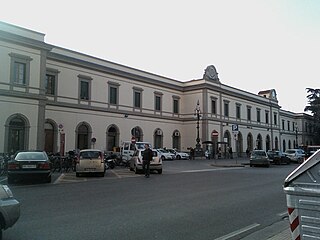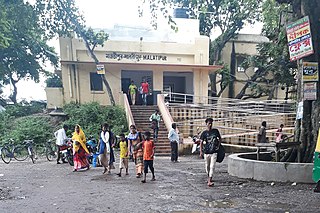The history of rail transport in Equatorial Guinea began in 1913, when a standard-gauge railway was constructed from the capital of Equatorial Guinea, Santa Isabel, to the nearby villages of Banapa and Basupo. In 1929 this railway was extended to the shore near Basupo but the line was unprofitable and was then closed. [1]
There is currently no rail transport in Equatorial Guinea. [2]

This article lists transport in Equatorial Guinea.
This page provides an index of articles on rail transport by country.

Guinea Equatorial Airlines (GEASA) is an airline based in Malabo, Equatorial Guinea. It was established and started operations in 1996 and operates domestic charter services. Its main base is Malabo International Airport.

Bata Airport is an airport serving Bata in Litoral, Equatorial Guinea. It is the second largest airport in Equatorial Guinea after Malabo International Airport.

Malabo Airport or Saint Isabel Airport, is an airport located at Punta Europa, Bioko Island, Equatorial Guinea. The airport was named after the capital, Malabo, approximately 9 kilometres (5.6 mi) to the east.

Lolabé is a small coastal town in Cameroon. It lies on the Atlantic Ocean, about halfway between Kribi and the border with Equatorial Guinea.
The Equatorial Guinea women's national football team, nicknamed the Nzalang Femenino, has represented Equatorial Guinea in senior international women's football competition since 2000. It is controlled by the Equatoguinean Football Federation, the governing body for football in Equatorial Guinea.

The following outline is provided as an overview of and topical guide to Equatorial Guinea:

Pistoia railway station is the station of Pistoia in Piazza Dante. It is on the Viareggio–Florence railway, which connects Florence and Viareggio and it is at the beginning of the Porrettana railway to Bologna.

Aeroflot Flight 418 was an international passenger flight operated by a Tupolev Tu-154A, registered CCCP-85102, that was operating the second leg of a scheduled Luanda–Malabo–N'Djamena–Tripoli–Moscow passenger service. The plane crashed into a mountain near Malabo Airport on Bioko Island, Equatorial Guinea on 1 June 1976.

Prato Centrale railway station is the main station serving the city and comune of Prato, in the region of Tuscany, central Italy. Opened in 1862, it forms part of both the Bologna–Florence railway and the Viareggio–Florence railway. Until 2002 it was named simply as Prato.

The history of rail transport in Slovenia dates back to 2 June 1846, the opening day of the Graz to Celje section of the Austrian Southern Railway. The events that day included the inaugural run of the first train to operate in Slovenia. The difficult and dangerous task of extending the line though challenging terrain to Ljubljana was completed by 1849. The line eventually continued to Trieste, now in Italy.

The history of rail transport in Greece began in 1869, with the construction of the link between Piraeus and Athens with private funding.

The history of rail transport in Latvia began with the construction in 1860 of a railway from Pytalovo to Dinaburg, 160 km in length, as part of the Saint Petersburg–Warsaw Railway.
A railway system existed in Mauritius from the 1860s until 1964. In 1956 the decision was made to close the railway due to unprofitability. At this time, Mauritius Government Railways had 146 km (91 mi) of 1,435 mm track and 47 locomotives. Freight transport continued until 1964 when the railway was scrapped.

The history of rail transport in Brazil dates back to 1835. In that year, Brazil's first Imperial decree was assigned to authorize a railroad which would connect Rio de Janeiro, Minas Gerais, Bahia, São Paulo and Rio Grande provinces and the main station would be in the Neutral Municipality (Corte) of Rio de Janeiro. However, the first railway line, with a gauge of 1,676 mm, was completed between the port of Mauá, in Guanabara Bay in the then province of Rio de Janeiro, and Fragoso, north of the Guanaraba Bay. Three steam locomotives made in England by William Fairbairn & Sons - which the more famous is the "Baroneza", hauled the trains on this 14 km (8.7 mi) short line.

Cronos Airlines is a regional airline headquartered in Malabo, Equatorial Guinea. Cronos Airlines is a passenger and cargo carrier based at Malabo International Airport in Equatorial Guinea. It operates a service in Equatorial Guinea, Cameroon, Benin and Nigeria.

Malatipur is a Kolkata Suburban Railway station on the Barasat–Hasnabad line. It is located in North 24 Parganas district in the Indian state of West Bengal.
Cannabis in Equatorial Guinea is illegal with severe penalties for the production, sale, and possession of marijuana for medicinal or recreational purposes. Despite the illegality, smoking marijuana remains culturally popular among all strata of society, and it was reported in 2000 that no one has been arrested for smoking or dealing cannabis in living memory.